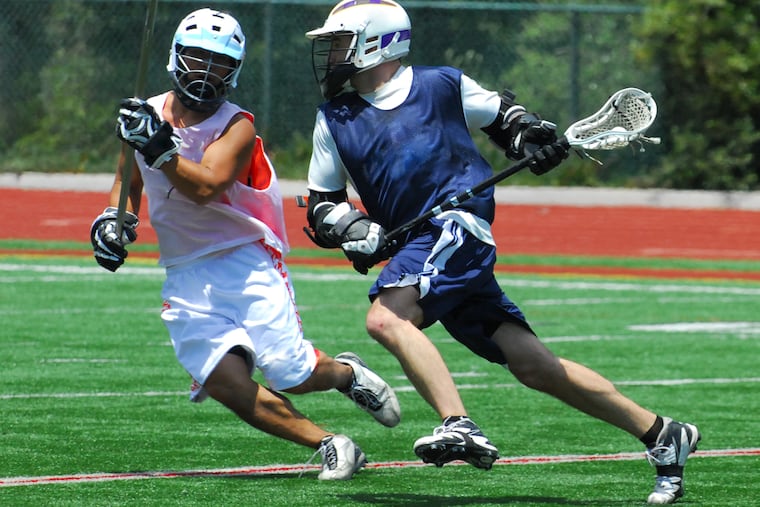COVID-19 and spring sports: How to help kids stay safe during the season | 5 Questions
Keep your guard up. With warm weather and being outside among teammates, it’s easy to forget about precautions. Remember to mask during team carpools and in locker rooms and other enclosed spaces.

Your kids have been cooped up all winter.
But now, pandemic restrictions are loosening. Children are returning to school. And the spring sports season is beginning. What’s in store?
Brian Vernau, a sports medicine pediatrician at the Children’s Hospital of Philadelphia Care Network in Glen Mills, noted in an online news tip that “we’re finally seeing tentative steps back to ‘normalcy’ amid the chaos.” Yahoo!
He allowed that “the upcoming sports season will look a bit different,” but “if everyone obeys the new state-mandated rules, our youth can safely compete again.”
We recently asked Vernau what parents can expect and how they can keep their young athletes safe.
Both the Pennsylvania and New Jersey Interscholastic Athletic Associations have issued new rules for youth sports.
In addition to all the usual social distancing, face coverings are now required for everyone, including athletes, parents and coaches during competition and on the sidelines.
However, the associations clarify that if distance can be maintained in the sport, there are instances where the mask can be taken off. For example, baseball fielders or runners maintaining distance during practice may not need a mask. Masks are not required in the PIAA for boys’ lacrosse players, as there is not a safe way to use a mask, mouthguard, and helmet together.
While the associations have outlined some areas where masks may be removed, athletes will need to remain masked both on the field and on the sideline in most cases.
It is difficult to wear a mask during sports. How can we help youth athletes do this?
My advice is to try several different varieties until you find one that fits and that your child likes. Every child is different and what may be comfortable for one athlete may not work for another. Once you find a mask that works, buy a couple of them. Some of the national sports brands are marketing masks that stay away from your mouth so it doesn’t collapse when you’re breathing heavily. Some are made to hook onto your ears to stay in place. Many athletes still use the blue surgical masks during competition which are also suitable if that is what they are most comfortable wearing.
What are some other tips for staying safe during sports activities?
Keep your guard up. With warm weather and being outside among friends and teammates, it’s easy to forget about a lot of these precautions, but everyone can have a successful season if we work together to prevent outbreaks. Remember to mask during team carpools and in locker rooms and other enclosed spaces.
Avoid sharing water bottles, towels, and equipment. No spitting. Viral particles travel further with spitting.
Finally, wash your hands frequently. What constitutes frequent when it comes to sports? A reasonable approach is to have hand sanitizer on the sidelines and sanitize any time you leave the field. The same goes for parents and coaches.
If your child has been indoors and relatively inactive, how should he or she start getting ready for sports?
Start now! Ideally, endurance training should begin four to six weeks ahead of the season. Start with walks or jogs and increase your mileage. If practices have already started, then you may have to go slow with the first couple of practices and build endurance from there.
For skills, try to get out a few weeks ahead of time to work on dribbling, passing, throwing and catching. Get those arms and shoulders warmed up for the season.
Here is a rule of thumb for endurance training among high school athletes:
Week 1: Run a mile every other day
Week 2: Run 1.5 miles every other day
Week 3: Run two miles every other day
Week 4: Run a mile every day
Week 5: Run 1.5 miles every day
Week 6: Run two miles every day
If your child’s coach or athletic trainer recommends adding strength training to your child’s preseason workout routine, you can modify the above to continue running every other day, and alternate with strength training. How long your child should practice strength training will depend on their physical condition, sport and specific recommendations.
Strength training, on the other hand, is more than lifting on weight machines in the school or public gym. With COVID-19 restrictions, we’ve learned how to be more creative when it comes to strength training. Most spring sports do not require heavy lifting. Smaller weights — such as 5 lbs., 10 lbs., and 20 lbs. — are often more effective at building strength for sports where agility is important (for instance, tennis vs. football).
Is all this enough to keep our children safe?
Outdoor sports have proven to be relatively safe during the pandemic if we follow the guidelines of distancing and masking when distancing is not possible. The outbreaks that we’ve seen tended to be more related to carpools, locker rooms and instances where kids let their guard down. If we all work together, this can be a successful and meaningful spring sports season.
Finally, remember to encourage kids to have fun! While there’s a lot for young athletes to remember this season, encourage them to focus on what they CAN do, rather than what they can’t. They can enjoy their favorite sport once again, revel in individual and team rivalries, and strive for their personal best each and every day.